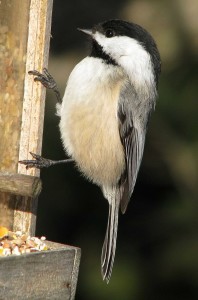Ode to a Chickadee
Note: This post is a bit of a departure from my usual blog posts, and was inspired by a weekend birding festival and a session on writing about birds presented by Bryan “Fox” Ellis, master storyteller, author, and educator.
A bird who is known for his black hat—
A harsh, dark color that captures and envelops his eye.
Yet underneath, his belly looks so downy soft,
Perhaps revealing the real bird—
Is his soul so soft?
Chick-a-dee-dee-dee—
“Who is the real me?”
—MCV 2018
What can we learn from the common chickadee? At first glance, the most striking visual clue is the black cap on his head, in sharp contrast to the white patch below and around the side of his cheek. Black and white, wrong and right, cut and dried. But wait—as we continue the color study on this little bird, the harsh black and white give way to shades of gray, as if to remind us that few things in life are truly black and white. It is the gradation that blends and binds us together on a continuum that, by itself, is not just two extremes, but a whole lot of middle ground to be explored and celebrated.
The chickadee’s lesson of harmony through difference has yet another dimension—the soft beige and white underbelly. Is this a sign of vulnerability—where things are NOT simply black or white or even on that continuum between the two? Or perhaps it is yet another reminder from Mother Nature that things in life are rarely so monochromatic and linear, but instead a full palette of color, texture, and purpose. Vulnerable? Maybe, but I’d like to think it a sign of strength and power.
Just as a tapestry gets its strength and beauty from interwoven threads and colors, the chickadee reminds us, even so subtly, that gentle colors are not a sign of weakness at all.
And what of his cheery call? The “chick-a-dee-dee-dee” chirping of a small bird flitting through the trees is one that is easy enough to be imitated by humans—imperfectly, to be sure. It’s hard to say “chick-a-dee-dee-dee” and not feel better for having done it. If our little bird hears our attempts to copy, does it register as an invitation for future discussion? Does he forgive our efforts to say, “Hello! Nice to meet you!” that may translate into avian gobbledygook?
I wonder if chickadees attempt to mimic our sounds. I’d like to believe that if he does, he only imitates the best, most uplifting expressions of hope and caring. Perhaps if we all behaved and spoke as if a chickadee was listening and practicing our words to sing back to us, the world would be a better place.
“The chickadee lives by joyous faith in living. His voice comes out of the cold silence like the last voice in the world, singing that everything which has gone under the snow is neither lost nor dead and that life survives beautifully somewhere else and will return. There is a joy in its song which says that everybody who is hiding from the storm is missing the best part.”
—Tom Brown, The Tracker
Photo: Pixabay.com
© Melissa Clark Vickers 2018
Back to home page.
January 22nd, 2018 at 4:41 pm
Beautiful! and inspiring! Who would have thought you could learn so much from a little chick-a-dee-dee-dee!